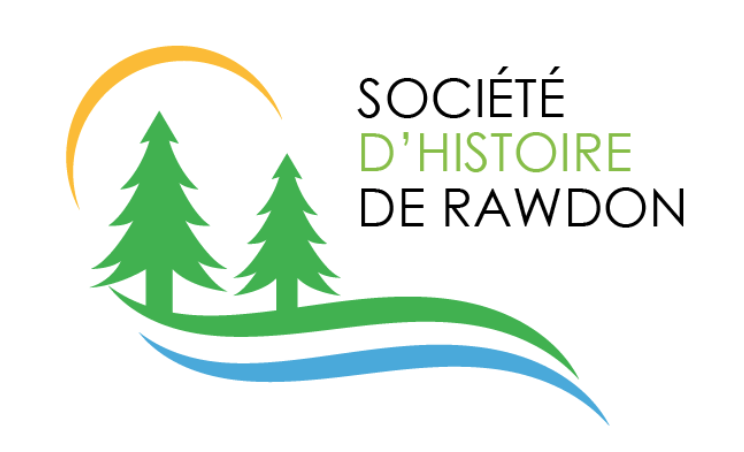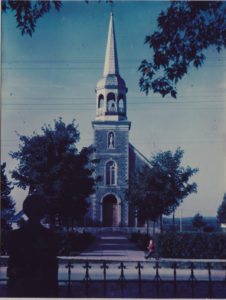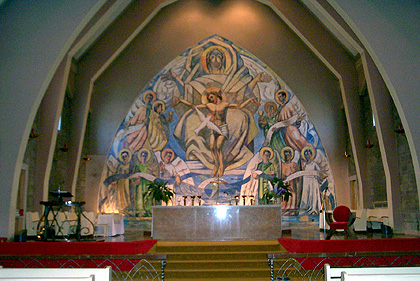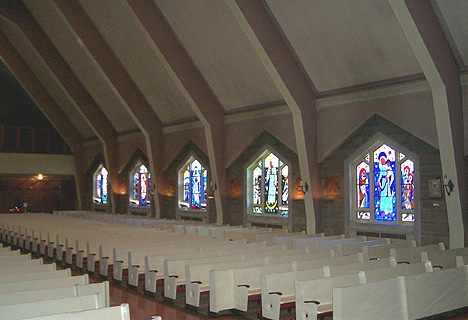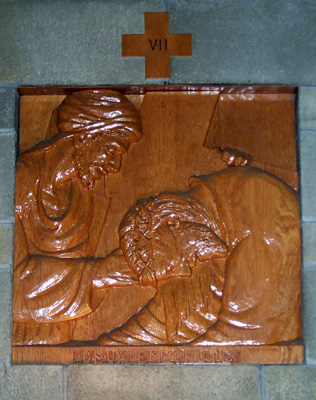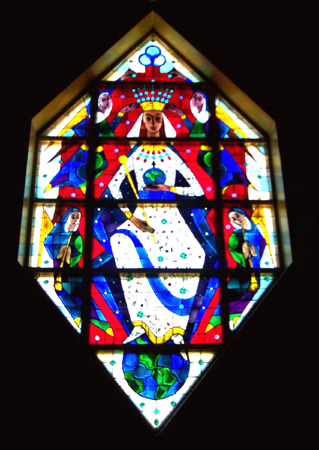The first Catholics of Rawdon
Before the arrival of the Irish, the history of the Catholic Church is interwoven with that of the mother parish, Saint-Jacques-de-l’Achigan. And one wonders how the first Irish families fulfilled their religious duties, since it seems that it was only two years after their arrival that they contacted the parish priest of Saint-Jacques, Mr. Jean-Marie Madran. Indeed, it was only in 1818 that several families went to the church in Saint-Jacques to have their children baptized.
Until 1825, given the lack of English-speaking priests, the religious authorities seemed to be troubled by this group of immigrants. Their numbers and their refuge on the banks of the Ouareau River were unknown.
In 1825, just as a solution was beginning to emerge, a jurisdictional conflict arose between the parish priests of Saint-Jacques and Saint-Paul, namely, Mr. Jean-Romuald Paré, and Mr. Jean-Marie Bellanger. Bishop Plessis of Québec authorized the latter to serve Rawdon: he was bilingual. For his part, Mr. Jean-Romuald Paré, parish priest of Saint-Jacques since 1819, continued to take a keen interest in this new mission since people came to him, Saint-Jacques being easier to get to than Saint-Paul.
Nonetheless, in 1825, during his first visit to the township, the parish priest of Saint-Paul proceeded to take a census of the local Catholic population. In his report, he indicated the presence of 127 Irish and mentioned the forthcoming settlement of a new group.
Bishop Lartigue, Bishop of Telmesse and coadjutor of the Bishop of Québec for the ecclesiastical division of Montréal, was quickly made aware of the problems of the Rawdon mission. The presence of other English-speaking Protestant groups and the arrival in 1821 of Reverend Burton, an Anglican minister, incited Bishop Lartigue to take serious care of these Irish Catholics. And, on January 20, 1826, he asked Father Bellanger to designate, on lot 23 of the 4th Range, the site of a wooden chapel measuring 30 feet by 20 feet with a sacristy measuring 18 square feet, part of which would serve as lodging for the missionaries who would visit the Catholics of this township. Finally, Bishop Lartigue authorized Mr. Bellanger, of Saint-Paul, to plant a cross on this 30-acre plot of land belonging to Mr. Peter Green (in Kildare Range, at the entrance to Lac Kildare Estate Road).
A chapel in Rawdon
The first official step was thus taken to provide Rawdon with a chapel. Although the location was chosen, construction did not begin until later. This site did not coincide with that of the Irish: they were set on their ideas and did not want to build the chapel in the place that the bishop had chosen. This impasse delayed the construction of this first Catholic temple. Mr. Bellanger therefore had to celebrate the religious services at the place where Father Jean-Baptiste McMahon used to celebrate them, that is, at the home of Mr. John Carroll, lot 17 of the 7th Range.
In addition to being served by the parish priest of Saint-Paul, whose parish was already vast, Rawdon was regularly visited by missionary priests from Montréal: all the English-speaking priests of the diocese having jurisdiction over Rawdon went there.
Until 1829, the parish priest of Saint-Paul was fully responsible for serving Rawdon. However, the parish priest of Saint-Jacques continued to be interested in the Irish of Rawdon, since they came to him. When Mr. Bellanger left Saint-Paul in 1829, Mr. Paré immediately took back the responsibility for the Rawdon mission, which he had abandoned in 1826. His desire to respond to the spiritual needs of the Rawdon population would be fulfilled: in January 1830, Mr. Louis Naud, vicar in Saint-Jacques, was appointed to take care of Rawdon, and Mr. James Moore, a missionary from Montréal, became an occasional visitor to the English-speaking population of the entire region.
In the meantime, the problem with the site of the chapel had not yet been solved, and Mr. Paré advised Bishop Lartigue “that it would be preferable to build the chapel in the centre of the village, because at the place previously chosen by Your Grandeur, there was only one Irishman, Mr. Peter Green.”
Mr. Naud did not stay long in Saint-Jacques. In that same year of 1830, he became the parish priest of Mascouche, which left Mr. Paré alone again to meet the religious needs of Rawdon. If the bishop did not want Mr. Paré to take charge of the Rawdon mission, it was certainly not because he was not fit to do so. The shortage of priests in the Montréal area, and the immense responsibility of the parish priest of “Greater Saint-Jacques,” a huge parish of more than 4,000 souls, constituted a difficult task: the bishop certainly could not further burden the devoted servant of God, “Saint Father Paré.”
Also, on November 30, 1830, Bishop Lartigue asked the parish priest of Saint-Jacques to ensure “that little Vinet (Jacques-Janvier) take good care of Rawdon, because I gave him to you for that purpose, and that he see to it that the Irish finish their chapel and establish a school there...”
The arrival of many Irish immigrants in 1828 and 1830 rapidly increased the population of Rawdon, which still did not have a chapel. Numerous requests continued to put pressure on the bishop to designate, without delay, a more suitable place than the first one for the construction of the chapel.
This situation could not continue. Rawdon was definitely causing concerns for the Bishop of Montréal, who had few priests and even fewer bilingual or English-speaking priests.
After having called upon the parish priests of Saint-Paul and Saint-Jacques, the bishop turned to another neighbouring parish priest, that of Saint-Esprit, Mr. Charles-François Caron, on June 8, 1831, to choose, with the consent of the parishioners, a site corresponding to the wishes of the majority. On August 9, 1831, Mr. Caron submitted his report, countersigned by Thomas Lane and James Daly. He recommended the construction of a chapel measuring 50 feet by 30 feet, and 15 feet high, on lot 17 of the 5th Range.
On the 26th of the same month, Bishop Lartigue accepted Mr. Caron’s report and gave the green light for the construction of the Rawdon chapel, which had been awaited for over five years.
He designated Saint Philippe as the titular of the mission. On October 27, he authorized Mr. Paré, in his capacity as archpriest, to bless a cross on the site of the potential construction. But there were still more obstacles; the land had to be obtained, which was not an easy task. According to the bishop’s latest instructions, the site could no longer be changed and the inhabitants had to accept the location.
In the meantime, Bishop Lartigue informed Father Paré that the titular of the Rawdon chapel would henceforth be Saint Gregory VII. This last change, dated December 17, 1832, was not made at the request of the population or the parish priest of Saint-Jacques. But the bishop, wanting to separate the territory of Kildare from that of Rawdon, gave this new name to the Rawdon service, and kept the name of Saint Philippe for Kildare.
However, the chapel was far from being started. Imagine, it took until March 1833 for a first meeting to be held on the subject. It was decided that Mr. Pierre Vaillant would preside over the construction of a wooden chapel measuring 60 feet by 40 feet, and 16 feet high, to be completed in October, the cost of the work amounting to 125 pounds sterling ($500). The chapel stood on the site of the present cemetery.
On April 18, 1833, at the second meeting, Thomas Lane, Edmond Archambault and Patrick O’Neil agreed to act as trustees to raise the funds needed for the construction. A few weeks later, they had raised the sum of 87 pounds and 18 shillings ($351.04). Although not all the money had been raised, the chapel was built all the same, and on September 21, 1834, mass was celebrated for the first time in the new chapel. This first mass was celebrated by Mr. L.-O. Deligny, vicar in Saint-Jacques.
Presbytery, cemetery and religious parish
Once the chapel was built, a presbytery was needed to accommodate the serving priests. Until then, the priest lived in a flat set up in the sacristy. A few months later, a house measuring 20 feet by 15 feet was completed against the church of Saint Gregory. A double stove, two beds and a confessional were installed there.
In June 1836, the cemetery was blessed by Mr. Roderick Ryder, in charge of the Rawdon mission and vicar in Saint-Jacques-de-l’Achigan. This land, adjacent to the church, was donated by Mr. Griffith, a Crown Lands agent.
The small service of Saint Gregory in Rawdon slowly took on the appearance of a religious parish. Being recognized as a parish would satisfy the population and provide a status that the settlers had long anticipated. In response to these aspirations, Bishop Lartigue appointed Mr. Dennis McReavy as parish priest of Saint-Philippe in Kildare (Saint-Ambroise) and Saint Gregory in Rawdon on November 15, 1837. Mr. McReavy would remain in Saint-Philippe and attend to the spiritual needs of the Rawdon faithful once or twice a week. Rawdon thus became an autonomous parish, even if the parish priest only resided there part time.
Mr. McReavy had been appointed minister on October 19, 1836, and he inaugurated the first parish registers on March 26, 1837, with the baptism, in Saint Gregory Chapel, of Thomas Boilen, son of Phelix Boilen and Anne Nancy, of Paisley. On March 31, 1837, was the first burial: that of Eleza Moore, aged two years and seven months, daughter of William Moore and Catherine Pratt, who had died the day before. A week later, the first marriage took place: that of John Doherty and Catherine Tanzy, whose father Peter was originally from Ireland.
On August 28, 1837, after the divine service, the first meeting of the church was held in the presbytery to elect the first three churchwardens. John Carroll, Luc Dupuis and Luke Daly were unanimously elected, with Mr. Carroll accepting the position of churchwarden in charge.
Bishop Lartigue advised Mr. McReavy that, from then on, the titular of the parish of Rawdon would be the Immaculate Conception of the Blessed Virgin, with Saint Gregory VII remaining as second titular. This was on June 3, 1838.
Since its beginnings, Rawdon had had many ministers from Saint-Paul, Saint-Jacques or Montréal. Finally, Bishop Bourget, to remedy this unstable situation, gave Rawdon a permanent priest. On September 10, 1840, this new bishop of Montréal wrote to Mr. McReavy that he was relieving him of the ministry of Saint-Philippe in Kildare, and that he was designating him parish priest of the Immaculate Conception in Rawdon. This letter from the bishop confirmed, beyond any doubt, that Mr. McReavy was the first parish priest in Rawdon.
Rawdon was finally becoming a real parish, even though the canonical erection did not take place until 1882, with a church, a presbytery and, most importantly, a resident priest. This permanent presence of Mr. McReavy was short-lived, however, because in January 1841, he was removed from Rawdon, without a designated successor. His departure did not please the parishioners, as they were left without a spiritual guide. For nearly four years, from 1841 to 1844, Rawdon’s Catholics were forced to go to Saint-Jacques to have their children baptized.
Resident priest and titular of the chapel
With the increase in the population and to counter the militancy of other religious communities, it was becoming important to send another priest to Rawdon. To accelerate the steps taken by the parish priest of Saint-Jacques, the tireless Mr. Paré, the inhabitants of the Immaculate Conception parish sent a request to Bishop Bourget on November 30, 1841, begging him to send a resident priest to Rawdon as soon as possible.
In addition to the problem of the resident priest, another equally important issue had arisen, that of the payment for the chapel. To cover the costs, there was a shortfall of nearly $150: this debt had been outstanding for a long time. The bishop had to get involved. He appointed Mr. Patrick Carroll, churchwarden in charge, and Mr. Dean Byrne, notary in Rawdon, to see that the necessary amount was recovered as quickly as possible. In addition, Bishop Bourget recommended that they wait until a priest was sent to Rawdon before dealing with the creditors, including Mr. Pierre Vaillant, builder of the chapel.
It was not easy to collect the required amount. The Irish felt that there was no point in having a chapel if there was no resident priest. The wait was quite long, because it was only on September 24, 1844, that Mr. Joseph-Amable Flavien Cholette was appointed vicar in Saint-Jacques with the responsibility for Rawdon. In the meantime, the sums due had been collected, and Bishop Bourget sent a letter of congratulations to Mr. Carroll and Mr. Byrne for the speed with which they had carried out their task. Mr. Cholette arrived in Rawdon and settled into the presbytery after visiting Mr. Paré to learn about his responsibilities.
On November 16, Mr. Cholette wrote to Bishop Bourget to share his impressions of Rawdon :
“As you told me, I found Rawdon very mountainous and difficult to access, but I had a very pure idea of it. On my arrival in Saint-Jacques, the good Mr. Paré received me with his well-known charity. I do not yet know all the people of Rawdon. I think they are good, if I judge by the eagerness they have shown to have the presbytery repaired, and they seem quite willing to pay their tithes...”
The poverty of the inhabitants, the organizational difficulties, the pitiful state of the roads and the competition from other churches did not make the task easy for the parish priest. However, the courage and charity of the small Irish settlement touched this devoted servant of God.
Not all the problems were solved, and others continually arose. In 1844, the Government sent instructions to surveyor James Dignam of Berthier, asking him to subdivide land 17 of the 5th Range, that is, the site of the village, into blocks and lots. This cadastre (January 8, 1845) slightly modified the direction of the lots, which obliged the church to obtain new land from the Government for the presbytery and the cemetery. Steps were immediately taken, and a few weeks later, the church obtained two acres of land. The old presbytery was too fragile to be moved, so the church decided to build a new, larger and more suitable one. On March 17, 1845, a funding campaign was undertaken in the parish, and the construction contract was signed before a notary.
The work was quickly completed, and by June of the same year, the parish priest of Rawdon occupied the second presbytery.
In the meantime, the titular of the chapel was changed once again. Indeed, the Irish had wanted Saint Patrick for a long time. On April 19, 1845, a request from the churchwardens and the parish priest asked for this change. The response was slow in coming; Bishop Bourget was probably not very keen on changing the patron saint a third time. Mr. Cholette sent a second letter to Bishop Bourget asking him to respond favourably to the wishes of the majority. Finally, on June 24, 1845, Saint-Jean Baptiste Day, Bishop Bourget informed Mr. Cholette that Saint Patrick would henceforth be the titular patron of the parish of Rawdon.
The Irish greatly appreciated this action. Religious life, finally launched, saw little change for several years. Many priests succeeded one another in the leadership of the parish. Apart from the fact that the parish was granted government lots in 1854, nothing disrupted religious life: Catholics and Protestants may not have lived on warm terms, but still were peaceful. It was a period of great progress. The population grew steadily, and Rawdon quickly became an important village because of the diversity of its ethnic groups, its industries and its numerous businesses.
Canonical recognition
In 1880, the parishioners of Rawdon wanted to have their church recognized as a canonical church. A request to this effect, signed by 79 inhabitants, was sent to Bishop Charles-Édouard Fabre of Montréal (December 21, 1881).On January 21, 1882, Bishop Fabre appointed Canon Paul Leblanc of the cathedral of Saint-Jacques to verify the merits of this request. On the following February 16, Canon Leblanc recommended that Bishop Fabre accede to the demands of the parishioners. The official decree of erection of the religious parish of Saint Patrick of Rawdon, in the county of Montcalm, judicial district of Joliette, was promulgated on February 28, 1882. In the same decree, the bishop recommended that procedures be undertaken immediately for civil recognition, which happened on June 7, 1882.
Construction of the first Catholic church
The year 1882 was therefore a significant religious date. For two years, the little Catholic chapel had been too small. The bishop was thus called on again to get his permission to build a new church that would better meet the needs of the ever-growing population.
Judging by the speed with which the request was studied, it seems that it was fully justified, since on August 25 of the same year, Bishop Fabre signed the decree allowing the church to proceed with the construction of the new place of worship.
However, this diocesan decree contained important and precise requirements. Let us remember four of them that would directly influence the construction of this temple:
1- The church shall be built of red brick.
2- It shall measure approximately 80 feet by 45 feet, and 22 feet high.
3- The sacristy shall measure 30 feet by 25 feet, and 13 feet high.
4- The construction shall take place only after the tabling of the plan.
After careful consideration of these requirements, the churchwardens accepted the decree on October 14, 1882. They immediately set to work. On October 24, Nazaire Bilodeau, Zéphirin Payette, Michael Skelly, Ambrose Rowan and Hugh Green were elected trustees and were responsible for the direction and supervision of the work.
The choice of the site had not yet been decided. The churchwardens and trustees were not in favour of building the future church on the site of the present cemetery. They preferred a site on Queen Street, which would have the advantage of being a little more central. They were fortunate when Dame Anastasie Dugas, wife of Firmin Dugas, a member of the House of Commons, bequeathed to the Rawdon church a huge piece of land located on Queen Street. This donation was made on the express condition that the parish decide to build the church on this site. The churchwardens eagerly accepted the donation and authorized Mr. Michael Skelly, churchwarden in Rawdon, to sign the contract as soon as possible.
Great relief for the administrators! Now they were able to undertake the actual construction. At the beginning of 1883, the trustees hired the architectural firm of J.-R. Poitras and V. Roy of Montréal to draw up the plans according to the decree of Bishop Fabre. Within a year, the specifications were prepared and submitted to the bishopric. All the requirements of the decree were met except for the first, that of the brick. The trustees claimed that brick could not be found and asked for cut stone for the façade and field stones for the rest. Even with this modification, the plans were accepted, and the project could begin.
Being authorized, on February 7, 1884, the trustees signed the construction contract with the Boileau et Frères Company of Île Bizard for $12,600. Under this contract, the church undertook to pay in 14 payments of $900 each, and the contractor was to deliver the church by Christmas 1886. After the contract was signed, work began and continued for more than two years to be completed on schedule.
Although the exterior work was completed, it was not until the summer of 1887 that it was fully finished. On June 5, 1887, the bell was blessed with all the usual solemnity in the presence of religious and civil personalities and a large number of faithful.
In 1886, the church also decided to build a new presbytery next to the new church: it went without saying. On November 28, 1886, the trustees received permission to build the presbytery. The construction contract was signed with Mr. Thomas Kite of Rawdon for $1,533.
The church requested authorization to sell the old presbytery. The bishop refused. The church then decided to move it to the church grounds where it would serve as a residence for the beadle and as a parish hall, known according to custom as the “salle des habitants.”
By 1888, the church and presbytery were completely finished and fully met local needs. Thereafter, many improvements were added according to discoveries or needs: electric lighting system in the church and presbytery in 1913, construction of a fence around the cemetery in 1925, and finally, in 1931, significant enlargement work on the church.
Indeed, the increase in the population and the development of tourism in Rawdon, compelled the church to build a transept on the church’s left side at a cost of $6,500. Then, under the direction of Father Beaudry, the land around the church and the presbytery was graded and embellished: few presbyteries have such a beautiful lawn that Bishop Vincent Piette and his successors have fortunately protected.
Construction of the second Catholic church
Even with this expansion, the need to build a new, more spacious and more modern church became apparent. Upon his arrival in Rawdon in 1939, Mr. Vincent Piette had the ambition of seeing a church built on the same site that would better meet the needs and aspirations of the citizens. Because of the war and Bishop Piette’s constant searches, the construction of the third church in Rawdon began on August 9, 1954.
On July 10, 1955, Bishop J.-A. Papineau blessed the cornerstone and gave the church a new titular: Marie-Reine-du-Monde, but kept Saint Patrick as the second titular. Bishop Piette, a great devotee of the Virgin Mary, had requested this addition following the Marian year in 1954.
The church, measuring 168 feet long by 56 feet wide, and 56 feet high, was inaugurated at the Christmas midnight mass in 1956. Finally, it was blessed by Bishop Édouard Jetté, auxiliary in Joliette, on August 19, 1956.
After having had one chapel (1834) and two churches (1886 and 1955), three presbyteries (1834, 1845 and 1887), five titulars: Saint-Philippe (1831), Saint Gregory VII (1832), the Immaculate Conception (1838), Saint Patrick (1845) and Marie-Reine-du-Monde (1955), the parish of Rawdon can now boast having one of the most beautiful temples dedicated to God. Nearly 140 years of courage and sacrifice have made it possible to build a church worthy of their aspirations.
Marcel Fournier, Rawdon: 175 ans d’histoire, Joliette, 1974, p. 62-81.
